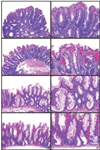Serrated polyposis is an underdiagnosed and unclear syndrome: the surgical pathologist has a role in improving detection
- PMID: 22790859
- PMCID: PMC3932441
- DOI: 10.1097/PAS.0b013e3182597f41
Serrated polyposis is an underdiagnosed and unclear syndrome: the surgical pathologist has a role in improving detection
Abstract
Serrated polyposis syndrome (SPS) is poorly defined and patients have an increased but unspecified risk for colorectal carcinoma through the serrated pathway. Despite this association SPS remains relatively obscure and is therefore likely underrecognized. We determined the frequency of SPS among patients with any serrated polyps (SPs) over a 6-month "index" period, and in doing so we assessed the ability of surgical pathologists to improve SPS detection. Particular attention was given to the index procedure to assess the potential predictive value of the findings resulting from a single colonoscopy. A total of 929 patients with at least 1 SP were identified, 17 of whom (1.8%) were determined to meet World Health Organization criteria for SPS. Nine patients met the first criterion (≥ 5 proximal SPs, 2 of which are > 10 mm); 4 met the third criterion (> 20 SPs of any size distributed throughout the colon); and 4 met both criteria. Although no specific SP size or number at the index procedure was clearly superior in its ability to predict SPS, > 50% of cases would be detected if a cutoff of ≥ 3 SPs or a single SP ≥ 15 mm at the index procedure is used. In summary, SPS is rare but more likely underdiagnosed. Additional studies to address the underlying genetic basis for SPS are ongoing in order to shed further light on this syndrome. Surgical pathologists are in a unique position to assist in this endeavor by identifying those patients who either meet or seem to be at high risk of meeting World Health Organization criteria.
Conflict of interest statement
Conflicts of Interest: None
Figures




Similar articles
-
Failure to recognize serrated polyposis syndrome in a cohort with large sessile colorectal polyps.Gastrointest Endosc. 2012 Jun;75(6):1206-10. doi: 10.1016/j.gie.2012.01.033. Epub 2012 Mar 15. Gastrointest Endosc. 2012. PMID: 22425271
-
Reassessment colonoscopy to diagnose serrated polyposis syndrome in a colorectal cancer screening population.Endoscopy. 2017 Jan;49(1):44-53. doi: 10.1055/s-0042-115640. Epub 2016 Oct 14. Endoscopy. 2017. PMID: 27741536
-
Detection rate of serrated polyps and serrated polyposis syndrome in colorectal cancer screening cohorts: a European overview.Gut. 2017 Jul;66(7):1225-1232. doi: 10.1136/gutjnl-2015-310784. Epub 2016 Feb 24. Gut. 2017. PMID: 26911398
-
[Serrated polyps and serrated polyposis syndrome].Cir Esp. 2013 Mar;91(3):141-8. doi: 10.1016/j.ciresp.2012.12.001. Epub 2013 Feb 13. Cir Esp. 2013. PMID: 23414940 Review. Spanish.
-
[The danger of serrated polyps in the colon: from sporadic polyp to polyposis syndrome].Ned Tijdschr Geneeskd. 2015;160:A9796. Ned Tijdschr Geneeskd. 2015. PMID: 27142501 Review. Dutch.
Cited by
-
Serrated polyposis: the problem of definition and its relationship to the population at risk for syndrome-related colorectal cancer.Transl Cancer Res. 2017 Dec;6(Suppl 9):S1480-S1483. doi: 10.21037/tcr.2017.11.16. Transl Cancer Res. 2017. PMID: 31179234 Free PMC article. No abstract available.
-
Guidelines for the management of hereditary colorectal cancer from the British Society of Gastroenterology (BSG)/Association of Coloproctology of Great Britain and Ireland (ACPGBI)/United Kingdom Cancer Genetics Group (UKCGG).Gut. 2020 Mar;69(3):411-444. doi: 10.1136/gutjnl-2019-319915. Epub 2019 Nov 28. Gut. 2020. PMID: 31780574 Free PMC article.
-
Multiplicity and molecular heterogeneity of colorectal carcinomas in individuals with serrated polyposis.Am J Surg Pathol. 2013 Mar;37(3):434-42. doi: 10.1097/PAS.0b013e318270f748. Am J Surg Pathol. 2013. PMID: 23211288 Free PMC article.
-
Frequency of serrated polyposis syndrome recognition by community endoscopists.Endosc Int Open. 2023 Oct 6;11(9):E888-E892. doi: 10.1055/a-2157-4125. eCollection 2023 Sep. Endosc Int Open. 2023. PMID: 37810899 Free PMC article.
-
Serrated polyps of the large intestine: current understanding of diagnosis, pathogenesis, and clinical management.J Gastroenterol. 2013 Mar;48(3):287-302. doi: 10.1007/s00535-012-0720-y. Epub 2012 Dec 4. J Gastroenterol. 2013. PMID: 23208018 Free PMC article. Review.
References
-
- Aaltonen L, Johns L, Jarvinen H, et al. Explaining the familial colorectal cancer risk associated with mismatch repair (MMR)-deficient and MMR-stable tumors. Clin Cancer Res. 2007;13:356–361. - PubMed
-
- Boparai KS, Dekker E, van Eeden S, et al. Hyperplastic polyposis and sessile serrated adenomas as a phenotypic expression of MYH-associated polyposis. Gastroenterology. 2008;135:2014–2018. - PubMed
-
- Boparai KS, Mathus-Vliegen EMH, Koornstra JJ, et al. Increased colorectal cancer risk during follow-up in patients with hyperplastic polyposis syndrome: a multicentre cohort study. Gut. 2010;59:1094–1100. - PubMed
-
- Burt R, Jass JR. Hyperplastic polyposis. In: Hamilton SR, Aaltonen LA, editors. Pathology and genetics of tumours of the digestive system. Lyon: IARC Press; 2000. pp. 135–136.
Publication types
MeSH terms
Grants and funding
LinkOut - more resources
Full Text Sources
Medical
Miscellaneous

